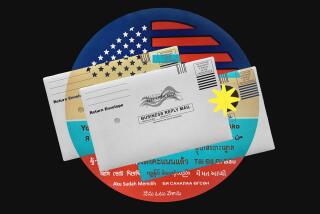Latino Veterans Braved Bullets, Bias in WWII
- Share via
Nick Alvarez, 77, of Placentia stood at Omaha Beach in the north of France three years ago and wept. “I must have cried 10 times,” he said. “How could you not?”
He remembered himself on that same beach 50 years before, leading a tankcrew during D-day, the Invasion of Normandy. The gunfire never seemed to stop, and he still wonders that he survived as the enemy downed tank after tank around him.
During that same 1944 invasion, Andrew Ortega, 73, of Anaheim arrived at nearby Utah Beach with a team of engineers, ahead of the infantry. “We were on our hands and knees frantically digging with our bayonets to uncover [land] mines no bigger than an egg,” he said. “They were shooting at us the whole time.”
Louie Armijo, 71, of Fullerton served in the Pacific theater during World War II, with the Army’s Air Force. Armijo will never forget the sergeant who at first tried to hold back his paperwork, declaring, “We don’t take Hispanics in the Air Force.”
These three veterans met for the first time this week in the Fullerton office of attorney Fred Aguirre. He’s been hearing a lot of similar war experiences these days. Aguirre, whose father Alfred is also a veteran of the second World War, is the driving force behind what many hope is the first annual “Tribute to Mexican Americans” who served in the military during World War II and the Korean War.
It will be held Sunday at 1 p.m. at the track field at Rancho Santiago College in Santa Ana.
Aguirre stresses that organizers are well aware that a great many veterans from a variety of ethnic and racial backgrounds deserve to be honored this Memorial Day weekend. He is in no way trying to minimize others’ contributions.
“But our children need to know that there were many many Latinos who fought for this country in those wars,” Aguirre said.
He gave a pretty good example to make his point: During World War II a Latino soldier who served in the Pacific was highly decorated for killing hundreds of enemy soldiers. His name was Guy Gabaldon. Hollywood went after his story. So who played Gabaldon in 1960’s “Hell to Eternity”? Blue-eyed Caucasian actor Jeffrey Hunter.
Latinos were fighting for their country, Aguirre says, at a time when they faced discrimination at home, the same as other minorities.
Nick Alvarez spent more than 10 months in constant combat after D-day. But growing up, he was forced to attend a segregated school in Placentia. A few years after the war, Louie Armijo applied for a teaching position in Fullerton. He was asked if he drank alcohol. Not at all, he insisted. Good thing: “There was only one bar in Fullerton and they wouldn’t serve Hispanics there,” he says.
I listened to these three veterans for more than an hour as they talked about their war years and showed me souvenirs they had gathered. Armijo had taken a photograph of the Enola Gay shortly after it returned from dropping the H-bomb over Japan. Ortega brandished a sword taken from a captured Nazi soldier, the engraved swastika a vivid reminder that it was meant for killing Allied soldiers.
All three said they feel honored to be participating in Sunday’s program. Armijo decided to write a paper about the upcoming experience for the organizers of the event.
Armijo wrote in part that he hopes “the efforts of the brave multitudes involved were all worthwhile.”
The Big Day: U.S. Rep. Loretta Sanchez (D-Garden Grove) and Rep. Esteban Torres (D-Pico Rivera) will be among the guest speakers at Sunday’s event. Also at the podium will be John Martinez, associate director of Chicano/Latino studies at UC Irvine, who will speak about Latino soldiers during American wars.
Here’s one you may not have read about in your history books: General Bernardo de Galvez led a 7,000-man all-Latino division in defeating the British during the Revolutionary War.
Also speaking: the students of Enriqueta Lopez Ramos, Cypress College professor of English, Spanish and social sciences, who will discuss the roles of Latino women at home during World War II.
In the nearby gymnasium, there will be a continuous showing of “The Men of Company E,” a documentary about a Latino company that fought in Italy during WWII. Its creator, independent TV producer Alfredo Lugo, will also be on hand, to participate in a panel discussion with Aguirre and Municipal Court Judge Frances Munoz, the first Latino to be appointed to the bench in Orange County.
Many of the veterans will bring pictures or war souvenirs. Linda Martinez Aguirre’s eighth-grade history class at South Junior High in Anaheim will display a 20-foot long mural depicting key Latino military heroes. Don’t be surprised when you see that it shows the Alamo. Fred Aguirre explained: “Nine Latino Texans died inside the Alamo.”
Wrap-Up: So often I get tripped up on the use of words such as “Latino” or “Hispanic” or “Mexican American.” For example, I got confused about Louie Armijo calling himself “Mexican American.” His father was a Basque, from Spain, and his mother an Apache. He was raised on an Indian reservation. Armijo’s ancestors were never from Mexico.
But he explained that he sees himself as Mexican American because that was the term used for all Latinos during World War II. He was proud then--and is proud now--to be under the Mexican-American banner.
Aguirre added: “Whatever their background, we want all Latino veterans, from all eras, to feel welcome at this event.”
More to Read
Sign up for Essential California
The most important California stories and recommendations in your inbox every morning.
You may occasionally receive promotional content from the Los Angeles Times.










